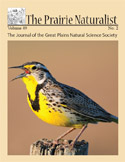Great Plains Natural Science Society
Date of this Version
12-2015
Document Type
Article
Citation
The Prairie Naturalist 47: 65–72. 2015
Abstract
The exotic grass Bromus tectorum (cheatgrass) is a ubiquitous invader in the western USA. Cheatgrass is a proficient competitor, frequently displacing native plants, forming monotypic stands and reducing biodiversity in ecosystems it invades. Our experiment tested whether short-term soil modification by cheatgrass and a predominant native grass, Pascopyrum smithii (western wheatgrass), affected subsequent growth of both species. We compared productivity of cheatgrass and western wheatgrass by harvesting aboveground biomass of plants grown in either cheatgrass- or western wheatgrass-conditioned soils over two simulated growing seasons. Results indicated that cheatgrass soils do not inhibit the productivity of the native grass, but do facilitate further growth of cheatgrass. Cheatgrass may alter soil characteristics, allowing it to invade other plant communities, but cheatgrass invaded soil did not inhibit growth of the native species studied here. This suggests that restoration with native species after control of cheatgrass may be possible.
Included in
Biodiversity Commons, Botany Commons, Ecology and Evolutionary Biology Commons, Natural Resources and Conservation Commons, Systems Biology Commons, Weed Science Commons


Comments
Published by the Great Plains Natural Science Society. Used by permission.